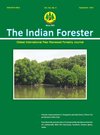In Vitro Sterilization Protocol for Micropropagation of Chimonobambusa jaunsarensis (Gamble) Bahadur and Naithani-A Rare and Endangered Hill Bamboo
DOI:
https://doi.org/10.36808/if/2016/v142i9/102539Keywords:
Sterilant, Contamination, Surface Sterilization and Explants.Abstract
For obtaining contamination free cultures, the most important step is sterilization of explants. In the present study, the sterilization procedure was standardized for Chimonobambusa jaunsarensis syn. Arundinaria jaunsarensis. Comparison was done between three important sterilants, HgCl2(0.05%, 0.1% and 0.15% w/v) for 5, 10 and 15 minutes; NaOCl (5%, 10% and 15% v/v) for 5, 10 and 15 minutes and H2O2 (5 %, 10% and 15% v/v) for 5, 10 and 15 minutes, supplemented with few drops of Tween 20 per 100 ml. Sterilized explants were inoculated on MS medium supplemented with 1mg/l BAP to evaluate the response of different sterilants. The present study has been done to standardize the sterilization method for explant of chimonobambusa jaunsarensis for in-vitro propagation intended for its propagation using different types of sterilizing agents by varying their concentration and duration of exposure. Result showed that amongst the three sterilants i.e. Mercuric chloride (HgCl2) Sodium hypochlorite (NaOCl), and Hydrogen peroxide (H2O2) HgCl2 was found better for controlling the infection with maximum number of healthy cultures.References
Agnihotri R.K., Janhvi M. and Nandi S.K. (2009). Improved in vitro shoot Multiplication and rooting of Dendrocalamus hamiltonii Nees et Arn. Ex Munro: production of genetically uniform plants and field evaluation. Acta Physiol. Plant, 31:961–967.
Bahadur K.N. and Naithani H.B. (1976). On a rare Himalayan Bamboo. Indian j. Forestry, 1 (1): 39-43.
Bisht P., Pant M. and Kant A. (2010). In vitro propagation of Gigantochloa atroviolaceae Widjaja through nodal explants. J. American Science, 6(10): 1019-1025.
Chawla H.S. (2003). Plant Biotechnology: Laboratory manual for plant biotechnology. Oxford & IBH Publishing Co. Pvt. Ltd. New Delhi.
Devi W.S. and Sharma G.J. (2009). In-Vitro Propagation of Arundinaria callosa Munro- an Edible Bamboo from Nodal Explants of Mature Plants. The Open Plant Science Journal, 3: 35-39
Falkiner F.R. (1990). The criteria for choosing an antibiotic for control of bacteria in plant tissue culture. Newsletter, Inter. Asso. for Plant Tissue Culture, 60: 13-23.
Hussey G. and Stacey N.J. (1981). In vitro propagation of potato (Solanum tuberosum L.). Ann. Bot., 48 (6): 787-796.
Kant A. (2008). In-vitro growth and multiplication of Berberis sp. and Melocanna baccifera. Ph D Thesis submitted to Forest Research Institute University, Dehradun.
Leifert C., Waites W.M. and Nicholas J.R. (1989). Bacterial contaminants of micropropagated plant tissue cultures. J. Appl. Bacteriol., 67:353361.
Leifert C., Morris C.E. and Waites W.M. (1994). Ecology of microbial saprophytes and pathogens in tissue culture and field-grown plants: Reasons for contamination problems in vitro. Critical Reviews in Plant Science, 13: 139-183.
Mudoi K.D. and Borthakur M. (2009). In vitro micropropagation of Bambusa balcooa Roxb. through nodal explants from field-grown culms and scope for upscaling. Current Science, 96 (7): 962-966.
Murashige T., Skoog F. (1962) A revised medium for rapid growth and bioassays with tobacco tissue cultures. Physiol. Plant, 15:473–497.
Negi D. and Saxena S. (2010). In-vitro propagation of Bambusa nutans Wall. ex Munro through axillary shoot proliferation. Plant Biotechnological Reproduction.
Downloads
Downloads
Published
How to Cite
Issue
Section
License
Unless otherwise stated, copyright or similar rights in all materials presented on the site, including graphical images, are owned by Indian Forester.





